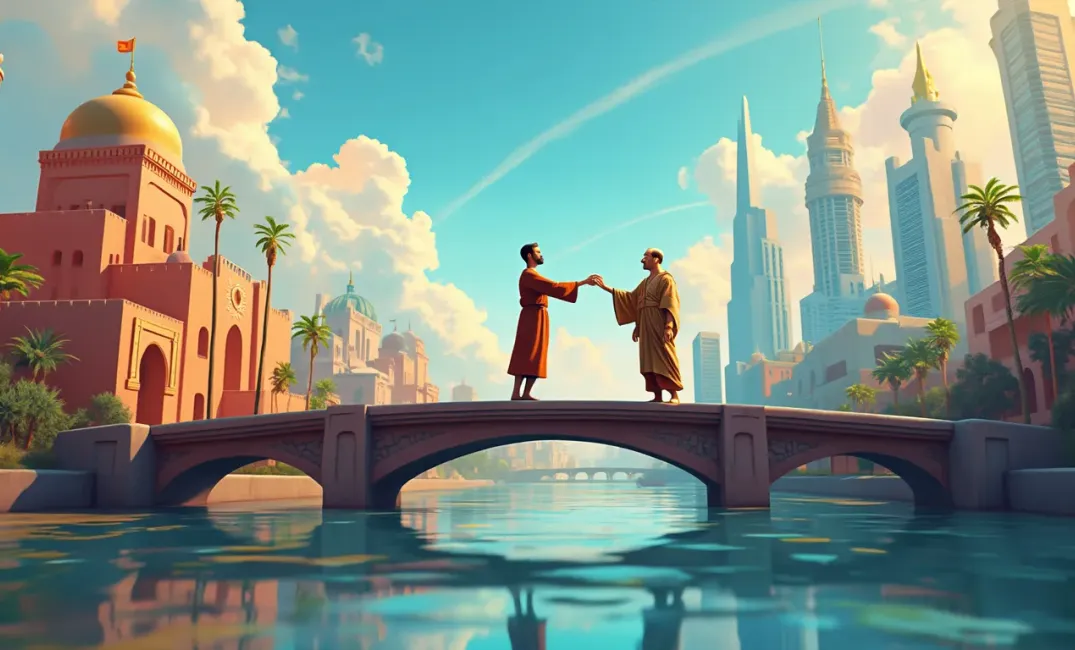Introduction: Understanding Human Conflict and Efforts for Peace
Human history has been fraught with conflicts and wars as well as persistent endeavors for peace and reconciliation. Understanding the evolution of conflict and diplomacy is crucial to guide future generations in navigating differences and fostering harmony in an increasingly interconnected world. This entry explores the multifaceted nature of conflicts and the critical role diplomacy has played throughout history, highlighting the complex dynamics between power struggles and peace efforts.
"In the midst of chaos, there is also opportunity." — Sun Tzu
The Roots and Causes of Human Conflict
Early Conflicts and Territorial Impulses
- Tribal Clashes and Resources: In humanity's nascent stages, conflicts primarily arose over resources such as land, water, and food, integral for survival. Inter-tribal tensions were often driven by territorial impulses and the need to ensure resource accessibility, leading to skirmishes and battles.
- Cultural and Ideological Differences: As tribes evolved into distinct societies, cultural and ideological differences began to spark conflicts. Early examples include clashes over spiritual beliefs and cultural practices, which often set the stage for larger geopolitical confrontations.
The Power Dynamics of Ancient Civilizations
- Empires and Expansion: As human governance structures became more organized, empires sought expansion to solidify power, resulting in conflicts that reshaped regions. Major empires such as The Roman Empire, the Persian Empire, and the Chinese dynasties waged wars to expand territories, asserting dominance over conquered lands.
- Internal Conflicts: Internal strife, often fueled by succession disputes, economic distress, or social inequalities, played pivotal roles in the weakening and collapse of empires, leading to power vacuums and geopolitical shifts.
Diplomacy's Birth: Negotiating Peace in Ancient Times
The Diplomacy of Early States
- Peace Treaties and Alliances: Early states recognized the need for diplomacy to establish peace and alliances. Egypt and The Hittites are noted for signing one of the first recorded peace treaties following the Battle of Kadesh. Treaties and alliances served as practical tools to ensure stability and prosperity.
- Trade and Cultural Exchanges: Diplomacy facilitated trade and cultural exchanges between civilizations, fostering interconnectedness. The Silk Road is a testament to how trade routes not only connected economies but also encouraged diplomatic interactions and the spread of cultural and technological innovations.
Religious and Philosophical Appeals
- Moral and Religious Appeals: Some cultures employed religion and philosophy as diplomatic tools, promoting ideals of peace and coexistence. Confucianism in China stressed harmony and ethical governance, influencing diplomatic relations and internal stability.
- Prophetic and Ethical Narrative: Societies interwove religious teachings into diplomacy, using divine narratives and ethical guidelines to shape relations and maintain peace. For example, the spread of Christianity during the Roman Empire influenced diplomatic strategies and cultural integration.
The Colonial Era: Conflict and Diplomacy Redefined
The Expansionist Impulse
- Colonial Conflicts: The Age of Exploration opened new territories, prompting European powers to colonize lands across the Americas, Africa, and Asia. Colonial endeavors often disregarded indigenous sovereignty, leading to conflicts rooted in exploitation and resistance.
- Technological Advancements in Warfare: The colonial period witnessed sophisticated advancements in weaponry and military logistics, intensifying conflicts' scale and impact.
Diplomacy in the Colonial World
- Global Diplomacy and Treaties: The colonial era established a foundation for global diplomacy. Treaties like the Treaty of Westphalia and the Congress of Vienna sought to define state sovereignty, balancing power in a rapidly changing world.
- Cultural Diplomacy and Missionaries: Beyond military and political engagements, cultural diplomacy emerged as missionaries and cultural emissaries spread religious, educational, and philosophical ideas, sometimes mitigating tensions.
The 20th-Century Landscape: World Wars and Global Diplomacies
Two World Wars: A Global Cataclysm
- Shifting Alliances and Ideologies: The early 20th century's geopolitical landscape was shaped by shifting alliances, nationalism, and ideological divides, culminating in two world wars that devastated nations and transformed political landscapes.
- Technological Warfare: The wars accelerated technological advancements in warfare, from mechanized infantry and tanks to nuclear weapons, reshaping future conflicts and ushering in an era where diplomacy was essential to avoid annihilation.
Diplomatic Reconstruction
- The League of Nations and the United Nations: The League of Nations, though flawed, represented an early attempt to unify diplomatic efforts for peace. Its successor, the United Nations, continues to play a pivotal role in conflict resolution and global cooperation.
- Post-war Order and New Alliances: Post-war diplomacy fostered cooperation through organizations like NATO and the Warsaw Pact, aimed at maintaining balance and preventing further global conflict, while the Cold War prompted strategic treaties like SALT to regulate arms proliferation.
Contemporary Conflicts and The Role of Modern Diplomacy
Regional Conflicts in a Globalized World
- Complex Interactions: Modern conflicts often involve complex interactions of ethnic, religious, and resource-based grievances. Regional instability in areas like the Middle East and Africa requires nuanced diplomatic approaches that balance local interests with international concerns.
- Non-state Actors and Cyber Warfare: Transnational terrorism, cyber warfare, and non-state actors challenge traditional diplomatic frameworks, necessitating innovation in diplomatic strategies and cooperation among nations.
Diplomacy in the Age of Globalization
- International Collaborations: Collaborative platforms, like the European Union and ASEAN, reflect the increasing importance of regional diplomacy in addressing economic, environmental, and security concerns.
- Digital Diplomacy: The advancement of communication technologies opens new channels for diplomacy. Social media and digital platforms allow for quicker responses and more inclusive dialogues, fostering real-time diplomatic engagements.
The Future of Conflict and Diplomacy: Governance and Cooperation
The Quest for Sustainable Peace
- Sustainable Practices and Resource Management: Addressing root causes like resource depletion, environmental changes, and social inequities are essential for sustainable peace. Diplomacy must incorporate climate diplomacy and environmental governance to mitigate conflicts over dwindling resources.
- Cultural and Ethical Engagement: Emphasizing cultural diplomacy and ethical engagement can bridge divides, promote mutual understanding, and harness the positive potential of diversity.
Global Governance and New Diplomacies
- Reimagining Institutions: Existing institutions need reimagining to address contemporary challenges, with an emphasis on inclusivity, representation, and adaptability to dynamic global landscapes.
- Tech-driven Diplomatic Innovation: Embracing technological advancements, such as artificial intelligence and blockchain, offers novel opportunities for transparent and efficient diplomatic processes that transcend geographic and bureaucratic hurdles.
Conclusion: The Eternal Balancing Act
The evolution of conflict and diplomacy reveals an eternal balancing act—man's struggle between the power of aggression and the aspiration for peace. As technology transforms warfare and globalization interweaves our destinies, innovative and empathetic diplomacy is imperative to navigating future challenges.
"Diplomacy is the art of building bridges. In times of conflict, may we always find the courage to reach out and bridge the divides." — Anonymous Diplomat
Through the dance of power and peace, the hope of diplomacy lies in its ability to weave the threads of cultural understanding, technological advancement, and ethical stewardship into a tapestry of global harmony. It invites us to envision a world where peace is not merely an ideal but a lived reality—an enduring legacy for future generations.
As humanity progresses, may we strive toward a horizon that embraces unity amidst diversity, crafting a world where diplomacy triumphs, illuminating the path toward shared futures.
PEACE, GLOBALIZATION, RESOLUTION, CONFLICT, HISTORY, NEGOTIATION, GEOPOLITICS, COLONIALISM, WAR, DIPLOMACY

